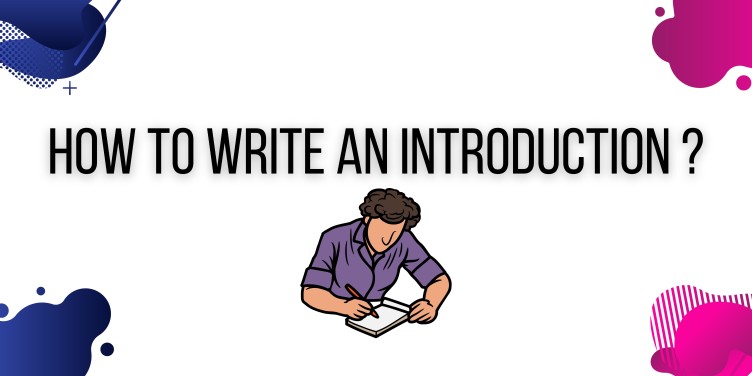
Whether you are writing an essay, a research paper, or any other form of written work, creating an effective introduction is an essential skill every writer must acquire. The introduction sets the tone for your work and should be exciting and educational to maintain the reader’s interest. This blog article will walk you through the process of writing an introduction step-by-step and provide some examples to help you grasp the ideas.
Step 1: Understand the Introduction’s Purpose
Understanding the objective of an introduction is the first step in creating one. Throughout your work, the introduction fulfils many crucial roles, including:
• Getting the reader’s attention: The introduction should be interesting and engaging enough to keep the reader reading.
• Establishing the tone: The rest of the work’s tone is established by the beginning. It should reflect the author’s tone, writing style, and viewpoint on the subject.
• Giving background information: The introduction needs to provide the reader with adequate background to grasp the issue and its importance.
• Outlining the key ideas: Everything the reader may anticipate to discover in the rest of the book should be outlined in the introduction.
Step 2: Brainstorm Ideas and Gather Information
Spend some time coming up with ideas and collecting relevant information before you begin writing your introduction. It will assist you in structuring your thoughts and composing a coherent and engaging beginning.
Here are some ideas to get you started:
• Evaluate your target audience: Who is going to read your work? What are their hobbies and points of view?
• Do research on the subject: Do extensive study on the subject to obtain essential facts that will assist you in creating a great introduction.
• Think about your thesis statement: The major argument or point you will make in your writing is stated in your thesis statement. The introduction should lay the groundwork for your thesis statement.
Step 3: Write the Introduction
Once you have gathered enough information and ideas, it’s time to start writing your introduction. Here is a step-by-step process that you can follow:
1. Start with a hook: Begin your introduction with a hook that will capture the reader’s interest. You can use an intriguing fact, a thought-provoking question, a quotation, or a narrative.
2. Provide background information: After your hook, add some background information on the issue to assist the reader in grasping its relevance.
3. State your thesis: Make your thesis statement as precise and concise as possible. Your thesis statement should be a one-sentence summary of your work’s main point or argument.
4. Preview the main points: Preview the main points you will discuss in the rest of the work. It will help the reader understand what to expect.
Step 4: Revise and Edit
When you’ve written your introduction, spend some time to revise and modify it. Here are some pointers to help you rethink and change your introduction:
• Read it aloud: Hearing your work aloud will help you detect any uncomfortable language or faults.
• Use active voice: Employ active voice instead of passive speech to make your writing more engaging.
• Remove unnecessary words: Remove any needless words or phrases from your introduction.
Introduction Paragraph Examples:
Example 1:
Hook: Did you know that over 90% of adults in the United States own a mobile phone?
Background: Mobile devices have altered the way we communicate and access information and have become an indispensable part of our life.
Thesis statement: In this essay, I will discuss the impact of mobile phones on our lives and society.
Preview: I will discuss how mobile phones have changed how we communicate, access information, and interact with our environment.
Example 2:
Hook: Imagine a world without music.
Background: Music has been an essential part of human culture for centuries, and it has the power to evoke emotions, memories, and connections between people.
Thesis statement: This research paper explores music’s role in human culture and how it has evolved over time.
Preview: In this paper, I will be discussing the origins of music, its cultural significance, and how it has been influenced by technology and globalization.
Example 3:
Hook: Have you ever wondered why some people are more successful than others?
Background: Success is a subjective concept that means many things to various individuals. But, successful people frequently display particular traits and behaviors.
Thesis statement: This essay will look at the essential traits of successful individuals and how to use them to accomplish both personal and professional goals.
Preview: The importance of goal-setting, resilience, and ongoing learning in attaining success will be covered in detail, along with several cases of successful people who exhibit these traits.
Conclusion:
A strong opening is crucial to drawing the reader in and establishing the scene for the remainder of your work. You can develop an informative, entertaining opening that sets the tone for the rest of your work by following the step-by-step procedure indicated in this blog article. Remember to correctly rewrite and edit your work to ensure it is clear, succinct, and error-free.
Upcopy.ai is a writing assistant that helps users improve their writing abilities with its 360-content analysis and real-time suggestions.
Signup on the platform for 14 day free trial by visiting upcopy.ai
#introduction #writing #writebetter #essaywriting #essay #aicontent
